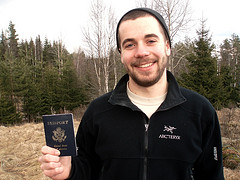3 Steps to Preventing Passport Theft and 5 Steps to Replace It
25 May 2012
If you’re traveling outside the country, your passport is a critical item on your packing list. It’s required identification to enter a foreign country, and even more important, it’s required to get back into your own home country.
Having your passport lost or stolen can turn an otherwise wonderful trip into a potentially expensive disaster. According to government experts, a U.S. passport is still a hot commodity on the black market, and as such, your passport should be carefully protected.
Let’s review how to prevent passport theft and what you’ll have to do if your passport is lost or stolen overseas.
3 Techniques to Prevent Passport Theft
Use these techniques to prevent your passport from being stolen:
- Keep it on the down low. Don’t be too conspicuous about your passport. Keep it hidden with other valuables like your credit card and cash.
- Take it out only when you have to. Show it only to officials who request it and put it away quickly when they are finished.
- Do not store it in your checked luggage (but do have a hard copy or digital copy of the ID page) or loose in an exposed exterior pocket.
There are conflicting opinions about whether you should keep your passport on you after you arrive or whether you should store it. Some travel experts note that you may need your passport in some countries depending on the security situation, and others say to lock it up in the hotel safe (not your in-room safe – those aren’t really safe).
Think about your travel destination and your travel itinerary and decide if you will need your passport on hand during any particular day or not. If you don’t need it, store it in your hotel safe inside a bag or envelope and be sure to get a ticket from the staff so you can collect it. Guard that ticket, of course.
There are a number of travel accessories that can help keep your passport safe. Some are worn around the waist, or slipped under your clothing. For the extremely cautious traveler, there are even water-safe protectors that keep your passport dry and safe when you take it swimming, diving, or snorkeling. Every traveler has to determine what works best for them.
5 Steps to Replacing your Passport
Passports are not usually issued abroad on weekends or holidays and any days the embassy or consulate is closed. These days can vary depending on the country you are visiting.
Hint: All of these steps here are much easier if you made two copies of your passport ID page before your trip.
When a U.S. citizen’s passport is lost or stolen overseas, these are the steps a traveler should follow:
- Contact the nearest U.S. embassy or consulate to inform them your passport is missing. You can find the phone and address information for U.S. embassies and consulates in the US State Department’s country-specific information pages.
- You’ll be required to execute an affidavit describing the circumstances under which your passport was lost or stolen. An official State Department form may be used or it may consist of a sworn statement before the consular officers.
- You’ll be required to fill out a passport application form and reasonably prove your identity and citizenship with personal data, including:
- your full name
- date of birth
- place of birth
- passport number
- date and place where your passport was issued
- You’ll be required to pay a fee to have your passport reissued (replacement passports are typically issued for the standard 10-year period, so it will essentially renew your passport).
- You’ll be required to provide passport photos (if you are traveling with extra copies and your passport was recently issued, you can use those spare copies). Otherwise, you’ll be directed to where you can get new photos.
A police report detailing the loss or theft of your passport is sometimes requested, but it is not usually required unless the embassy or consulate believes there may be possible fraud. If you do have to file a police report, get extra copies – one for the embassy, one for you, and one for your travel insurance claim. In fact, you’ll want to ask for copies of all the forms and statements for your travel insurance claim.
How can travel insurance help?
Many travel insurance plans include coverage for lost or stolen passports, including:
- Cancelling your trip before departure if your passport is stolen and it cannot be replaced in time.
- Reimbursing the fees (up to the plan limit and usually about $50) required to reissue the passport.
You’ll need receipts for the fees charged and documentation that your passport was reported lost or stolen, so be sure to ask for an extra copy of those items.
Damian Tysdal is the founder of CoverTrip, and is a licensed agent for travel insurance (MA 1883287). He believes travel insurance should be easier to understand, and started the first travel insurance blog in 2006.

